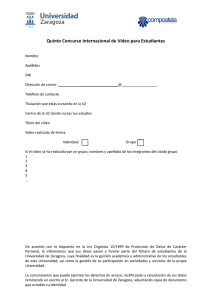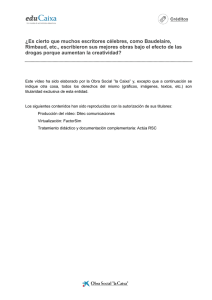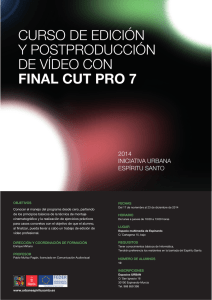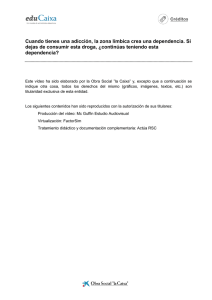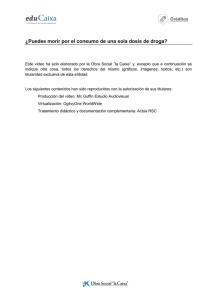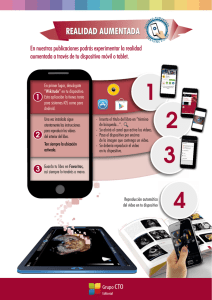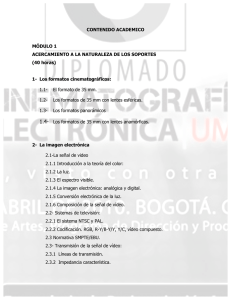COLECTIVO ACCIONES DE ARTE (CADA)
Anuncio
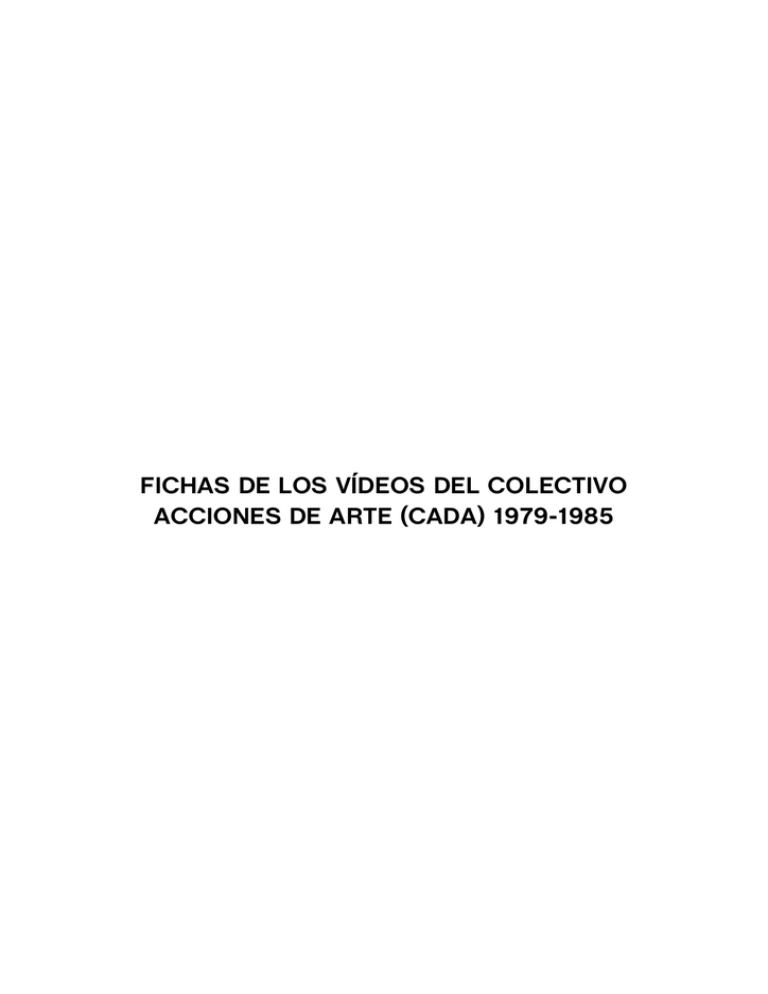
FICHAS DE LOS VÍDEOS DEL COLECTIVO ACCIONES DE ARTE (CADA) 1979-1985 Para no morir de hambre en el arte In Order Not to Starve to Death in Art Chile, 1979. Vídeo, 5’ 23’’ Con el trabajo Para no morir de hambre en el arte, tomando como metáfora la leche signo de blanco, de hambre y de carencia- se dio inicio a una obra progresiva que abarcó desde el vídeo registro hasta las revistas de análisis político, pasando materialmente por los cuerpos segregados de los habitantes más desposeídos de la ciudad. El vídeo da cuenta del conjunto de las “acciones de arte” realizadas por el colectivo el día 3 de Octubre de 1979, donde se intervinieron simultáneamente cuatro espacios significativos que conforman la realidad chilena. 1. Sector Poblacional: distribución de 100 litros de leche en una población de extrema pobreza de Santiago. 2. Medio de comunicación masivo: ocupación de una página como información de arte en la revista HOY. 3. Organismo Internacional (exterior CEPAL): emisión por altavoces del discurso No es una Aldea, en los cinco idiomas oficiales de Naciones Unidas. 4. Galería de Arte: sellado de una caja de acrílico con 80 bolsas de leche, un ejemplar de la revista HOY y la cinta de audio con el discurso No es una Aldea. The piece entitled In Order Not to Starve to Death in Art, which used milk –a symbol of whiteness/blankness, hunger and need– as a metaphor, marked the beginning of a progressive project that encompassed everything from the archival video to political analysis journals, and in the process literally passed through the segregated bodies of the city’s most dispossessed inhabitants. The video documents the various “art actions” that the collective staged on October 3, 1979, when they simultaneously appropriated four significant spaces that defined the reality of life in Chile at that time. 1. Population Sector: Distributing 100 litres of milk among the inhabitants of an extremely poor area of Santiago. 2. Mass Media: Taking out a full page as art news in HOY magazine. 3. International Organisation (outside ECLAC): Broadcast the speech “No es una Aldea” [It’s Not a Village] over loudspeakers in the 5 official languages of the United Nations. 4. Art Gallery: Packing and sealing an acrylic box containing 80 bags of milk, a copy of HOY magazine and a cassette tape with a recording of the “No es una Aldea” speech. Inversión de escena Scene Inversion Chile, 1979. Vídeo, 5’ 05’’ Ocho camiones lecheros iniciaron, desde una industria láctea, un recorrido programado por la ciudad de Santiago para finalizar alineados frente al Museo Nacional de Bellas Artes. Esta unión se consumó con la extensión de un lienzo de 100 m2 que clausuró la entrada al Museo. El blanco que clausuraba el Museo implicaba que el arte estaba afuera, diluido en la ciudad, semi-clandestino. Eight milk trucks set out from a dairy factory and followed a predetermined route through the city of Santiago to the Museo Nacional de Bellas Artes, the National Fine Arts Museum, where they parked in single file. This union was consummated with the unfurling of a 100square-metre canvas that blocked the museum entrance. The white cloth closing off the museum implied that art was actually to be found outside its doors, diluted in the city, almost in hiding. ¡Ay Sudamérica! Oh, South America! Chile, 1981. Vídeo, 4’ 35’’ Seis avionetas civiles, sobrevolaron la ciudad de Santiago dejando caer en sus comunas más populosas, 400.000 panfletos sobre la relación entre arte y sociedad. Six civilian aircraft flew over the city of Santiago, dropping 400,000 pamphlets about the relationship between art and society on its most densely populated districts. El fulgor de la huelga The Blaze of the Strike Chile, 1981. Vídeo, 0’55’’ El grupo CADA realizo la puesta en escena de una huelga de hambre en el interior de una pequeña industria metalúrgica que había quebrado por la grave crisis económica que atravesaba el país. La incursión del CADA en ese espacio, apuntó a denunciar la situación de desempleo que atravesaba el mundo obrero, como también privilegiar la huelga de hambre como arma política de resistencia. The CADA collective set the stage for a hunger strike inside a small metallurgical factory that had gone bankrupt due to the severe financial crisis in Chile at the time. CADA invaded this space with the aim of denouncing the crippling unemployment rate among the working class and promoting the hunger strike as a weapon of political resistance. A la hora señalada At the Appointed Hour Chile, 1982. Vídeo, 1’42’’ En el interior de un taller artesanal se realizó la performance A la hora señalada, (sólo ante el peligro) cita del film del mismo nombre que da cuenta del duelo. Se recoge esta cita en un sentido doble: en tanto denuncia de la violencia chilena y como síntoma de pérdida y recogimiento. The performance entitled A la hora señalada, the title under which the famous Western showdown film High Noon was released in Latin America, was staged inside a craftsman’s workshop. In this case the title has a dual significance: it is both a denunciation of violence in Chile and a symptom of loss and withdrawal. NO + No More Chile, 1983. Vídeo, 5’42’’ A partir del décimo año de la Dictadura Militar (1983), el CADA construyó la consigna NO +. Se eligió esta consigna como texto abierto para ser completado por la ciudadanía, de acuerdo a sus particulares demandas sociales. Se invitó a artistas chilenos provenientes de diversas disciplinas a iniciar los rayados murales en la ciudad. El vídeo recoge las intervenciones ciudadanas de este rayado y su multiplicación en los espacios públicos. La consigna propuesta por el CADA alcanzó una extraordinaria masividad y relevancia durante los siete años que antecedieron al fin de la Dictadura. In the tenth year of Pinochet’s military dictatorship (1983), CADA came up with the NO + slogan. It was chosen as an open-ended phrase to be completed by citizens, according to their particular social demands (No more ...). Chilean artists from different fields were invited to start spreading this message on walls all over the city. The video shows citizens participating in the creation of these graffiti messages and their proliferation in public spaces. The slogan proposed by CADA became massively popular and significant in the last seven years of the dictatorship’s existence. Viuda Widow Chile, 1985. Vídeo, 1’17’’ Trabajo de prensa-acción. Inserción del retrato de una mujer cuyo marido había sido asesinado en el curso de una protesta nacional en contra de la dictadura militar, con un texto alusivo a su condición y a su situación social. Este retrato fue incluido como trabajo de arte en las revistas Análisis, Cauce, Hoy y el diario Fortín Mapoch en septiembre de 1985. Todos estos medios de comunicación eran críticos a la dictadura militar. This media-action project involved the insertion of the portrait of a woman whose husband had been killed during a nationwide protest against the military dictatorship, accompanied by a text referring to her status and social situation. The portrait was published as a work of art in Análisis, Cauce and Hoy magazines and the daily paper Fortín Mapocho in September 1985. All of these publications were critical of the military dictatorship. Documental CADA CADA Documentary Chile, 1993. Vídeo, 22’33” El documental reúne entrevistas en torno a la obra del CADA desarrollada entre los años 1979-1985, además recoge fragmentos de las obras individuales realizadas durante ese período por sus integrantes. The documentary features interviews which discuss CADA’s activity in the years from 1979 to 1985 as well as fragments of the individual works produced by its members during that period.
